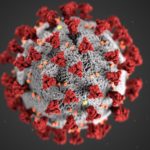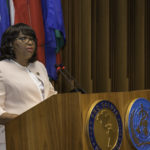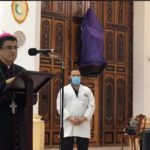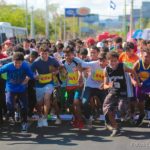In this edition
- Nicaraguan Journalism Celebrated Today, While Journalists Remain Under Siege.
- Young Nicaraguans Protest Inside the UCA.
- Editorial Cartoonists Reflect on Press Freedom on National Journalists’ Day.
Nicaragua has reached day 318 since the beginning of the crisis. Today representatives of the OrMu administration and the Alianza meet again, Nicaraguan journalists celebrate their day, and repression continues. Here are some of the news unfolding this morning.
Nicaraguan Journalism Celebrated Today, While Journalists Remain Under Siege
In 1964, the Nicaraguan Legislature established March 1 as National Journalists’ Day, to commemorate the printing of Nicaragua’s first news paper, El Diario de Nicaragua, created by Rigoberto Cabezas. However, the day was not intended as a celebration of press freedom. It was meant to be paid vacation day for “all intellectual laborers […]” in the press.
This year, National Journalists’ Day is a somber occasion, as Nicaraguans again live under a dictatorship. OrMu has done everything in its power to quash press freedom and limit Nicaraguans access to information that should be public. OrMu has also done much harm to the women and men of the independent press, who are considered threats to the status quo.
Journalism, after all, is about comforting “the afficted” and afflicting “the comfortable.” That is true of Nicaraguan independent journalists. They have done their job, and many of them have paid a hefty price for it.
According to the Fundación Violeta Barrios de Chamorro, fifty-four Nicaraguan journalists are currently exiled. One is dead, and two are in prison, where they are held in isolation. The Fundación also reported over seven hundred violations of press freedom, including acts of intimidation, censorship, threats, physical aggression, occupation of buildings and seizure of assets, including equipment and materials, and other incidents that make it virtually impossible for journalists to do their jobs without fear.

Today, we remember journalist Angel Gahona, who was gunned down while covering the protests in Bluefields.
Justicia #SOSNicaragua pic.twitter.com/IQXGMk1SHw
— Jorge Mejía Peralta (@jmejiap) March 1, 2019
Today, we also pay homage to the journalists who have been unjustly imprisoned, including Miguel Mora, Lucía Pineda, Hansell Vasquez, and Marlon Fonseca. Journalist Carlos Fernando Chamorro took to Twitter, demanding justice for the murder of Angel Gahona and the liberation of Miguel Mora and Lucia Pineda.
Celebramos el Día Nacional del Periodista demandando justicia por el asesinato de Angel Gahona, la liberación de Miguel Mora y Lucía Pineda Ubau, y la anulación de todos los juicios políticos. No a la criminalización del periodismo. Sigamos derrotando la censura y la autocensura
— Carlos F Chamorro (@cefeche) March 1, 2019
In similar vein, photographer Frank Cortés is walking the streets of Managua, demanding the release of Mora and Pineda, who have been in solitary confinement since December.
Esto fue hace pocos minutos en una de las calles de Managua. El fotoperiodista Frank Cortés, recorrió algunas calles de la capital, en el día del periodista, y en apoyo a los periodistas presos Miguel Mora y Lucía Pineda. pic.twitter.com/mr0CWJmPGx
— BOLETIN ECOLOGICO (@BOLETINECOLOGI) March 1, 2019
Journalist Wilmer Benavidez, on the other hand, has asked his followers to “flood social media with pictures of Marlon Fonseca and Hansell Vasquez.”
Hola, ¿me ayudan a inundar las redes sociales con las fotos de Marlon Fonseca y Hansell Vásquez? Mañana es Día Nacional del Periodista y ambos son presos políticos del régimen. Demandamos su libertad. Son inocentes. #SOSNicaragua pic.twitter.com/ksAmsoUnti
— Wilmer Benavides Fonseca (@chepitillo1) February 28, 2019
Newspapers are also under attack. Today has been five months since the Dirección General de Aduanas (DGA) — Customs Enforcement — seized paper, ink, and parts belonging to La Prensa and El Nuevo Diario. Both daily newspapers have been forced to reduce the number of pages per edition, in an effort to stay alive and continue bringing news to all Nicaraguans who want to read newspapers. In an interview with Articulo 66, Douglas Carcache, of El Nuevo Diario, characterized the act of the DGA as illegal
What they are doing is illegal. That is against the law, and it is a political action with the intention of blocking and impeding freedom of the press.
https://youtu.be/g6Wek38faXw&start=99&end=116
In the same interview, Jaime Chamorro (La Prensa), stated that the DGA was acting under orders from the presidency. However, Mr. Chamorro believes that the Nicaraguan press will prevail in the end.
We will prevail against this government, just like we prevailed against Somoza and against the Sandinistas [in the 1980’s]. We will overcome.
https://youtu.be/g6Wek38faXw&start=168&end=178
And though over fifty journalists have been forced into exile, they continue working to inform the Nicaraguan people. Journalists are using digital platforms, and they keep reporting in spite of everything. Gerall Chavez, Leticia Gaitan, Hector Rosales, and Yelsin Espinoza started “Nicaragua Actual” from exile today. This is their first broadcast, via Facebook Live.
They are not the only ones. Nicaraguan journalists exiled in Spain have started Despacho505, while their colleagues in Costa Rica formed Nicaragua Investiga. Similarly, the team at Confidencial is still producing and broadcasting its popular programs, Esta Semana and Esta Noche from Costa Rica, led by Carlos Fernando Chamorro, and the team at Cafe con Voz is still at it, from the United States, after its director, Luis Galeano, went into exile.
Nicaraguan independent journalists have a lot to be proud of.
Thank you for all your hard work and sacrifice.
Young Nicaraguans Protest Inside the UCA
A group of students at the Universidad Centroamericana, UCA staged a protest inside the grounds of this Jesuit institution in Managua. The students are demanding “justice for the dead and for the political prisoners of the regime.” The protest was announced yesterday, via social media.
Los estudiantes de la UCA alzarán su voz mañana viernes. Proponen un punto de agenda para la negociación: "Que se vayan". Esta vez será adentro del recinto, la Policía no puede intervenir. La juventud debe desarrollar su pensamiento crítico y ejercer sus derechos #SomosUCA pic.twitter.com/whjoOVyJOJ
— Uriel Velásquez (@urielvelasquezz) February 28, 2019
Police presence in the area around the UCA, Metrocentro, and the Cathedral has been ongoing, as shown by pictures and video showing an exaggerated and militaristic surveillance of public spaces.
Ortega anunció la instalación de una mesa de negociación para el próximo miércoles, pero mantiene el asedio policial en las calles, rotondas y principales avenidas de Managua
Imágenes de la UCA#SOSNicaragua pic.twitter.com/JCMGfV5HQX
— El Tranque (@tranquenic) February 22, 2019
Nevertheless, about 30 students participated in today’s protest, according to La Prensa. In the video, you can see them singing the Nicaraguan national anthem.
Estudiantes de la @UCAdeNicaragua realizaron un pequeño plantón en el interior del recinto para demandar justicia por los muertos y presos políticos del régimen. @laprensa pic.twitter.com/pOp7RDckw3
— Ivette Munguia (@Ivymunguia) March 1, 2019
The students also chanted “¿cuál es la ruta?” [what is the route?] a slogan that should now be considered to have a dual meaning. First, it refers to a botched OrMu propaganda attempt¹; second, it refers to the lack of information about the agenda of the negotiations, which the Alianza usually calls “the route.” Students also chanted insults against Daniel Ortega and Rosario Murillo.
¿Cuál es la ruta? Preguntan los jóvenes en la UCA donde realizan una protesta. #SOSNicaragua
— Wilmer Benavides Fonseca (@chepitillo1) March 1, 2019
Journalist Tifani Roberts (Univision) covered the protest, commenting that students “Have no choice but to protest inside the university”. In September, OrMu Police declared public protesting to be illegal without prior authorization.
Students at the UCA, though, are protected as the university is not a public space, but a private institution of higher education. Moreover, according to Article 9 of the University Autonomy Law, police cannot enter a college campus without written authorization from the university itself. That is not going to happen at the UCA, as it is an institution that has consistently opposed OrMu’s abuses, and even open its campus as a refuge for protesters who came under attack on May 30, 2018 during the “Marcha de las Madres,” the Mother’s Day March.
@UCAdeNicaragua no les queda de otra que usar su derecho a expresarse adentro de la Universidad. Es un delito ser estudinte en #Nicaragua #SOSNicaragua pic.twitter.com/uGIFu7xtBo
— Tifani Roberts (@TifaniRoberts) March 1, 2019
Soon, police in riot gear surrounded the campus. According to Despacho505, at least six police pick up trucks ferried officers to the area.
El despliegue policial se mantiene en el sector de la UCA. La última vez que la población intentó marchar fue en octubre. En esa ocasión, más de 30 personas fueron detenidas de forma ilegal y posteriormente, liberados. Estudiantes marcharon hoy adentro de la UCA.@laprensa pic.twitter.com/ajGnYrLO83
— Cinthya Torrez (@cinthyabri) March 1, 2019
In addition, local media reported that Tifani Roberts was hit by a rubber bullet, while while she was in the area “around the university.” Ms. Roberts stated, via Twitter, that she is ok, but no further information details are available at this time.
Estoy bien. No se preocupen. Todo tranquilo.
— Tifani Roberts (@TifaniRoberts) March 1, 2019
Though the UCA protest is significant, it is not the first or only act of civil disobedience that has occurred since the start of the OrMu-Alianza negotiations. On Wednesday, a group of at least four young people protested on the grounds of the Immaculate Conception Cathedral in Managua.
#AHORA Ciudadanos con ganas de expresarse en las calles salen de los predios de la catedral de Managua con banderas azul y blanco. Policía tiene militarizada la zona 🚨📱
📹 Cortesía pic.twitter.com/gjZqtifZEt
— nicaraguainvestiga (@nicaraguainvest) February 27, 2019
En la Catedral de Managua esta tarde. Chavalos sin miedo con la única bandera que nos cobija #YoSoyAzulYBlanco 🇳🇮 jamás, jamás la dictadura podrá detenernos #SOSNICARAGUA #YoHabloALaAlianza pic.twitter.com/lX37yP9bOT
— 🇳🇮Joshy💙💙💙💙💙💙 (@JoshyCastillo) February 27, 2019
Police in riot gear soon descended on the area, forcing the young protesters to take refuge inside the cathedral.
La Policía asedia la Catedral de Managua porque hay cuatro jóvenes con banderas de Nicaragua cantando el Himno Nacional. Así está la zona en estos momentos #NicaraguaInvestiga pic.twitter.com/Y4xF4pTiWC
— nicaraguainvestiga (@nicaraguainvest) February 27, 2019
The protesters were later able to leave, thanks to the Fr. Maykel Monterrey and the nuns of the order of Christ the King, who convinced the police to allow the protesters to exit the premises.
++++ÚLTIMO MINUTO++++
Jóvenes que realizaron una protesta exprés en Catedral Metropolitana de Managua, quiénes estaban refugiados en el templo por temor a Policía orteguista; HAN LOGRADO SALIR sanos y salvos gracias a labor del padre Maykel Monterrey y religiosas de Cristo Rey.
— Israel González Espinoza (@israeldej94) February 28, 2019
The situation at the UCA is still developing as of this writing.
Editorial Cartoonists Reflect on Press Freedom on National Journalists’ Day.
You can’t really say “happy journalists’ day” to a Nicaraguan journalist these days. There is nothing to celebrate, but there is much to think about. Here are some images from Nicaragua.
#DiaNacionalDelPeriodista
Nada que celebrar#Nicaragua #DerechoAInformar #PrensaNacional #prensalibre #SOSNicaragua #Nicaragualibre pic.twitter.com/obdYiL0gAF— CaKo (@CaKoNicaragua) March 1, 2019
“El periodismo y el humor no pueden callar”, dice el caricaturista @pxmolina a propósito del #DíaNacionalDelPeriodista https://t.co/Q0hf8TXdPq pic.twitter.com/L1ZRqMYuVr
— Yader Luna (@Lunacero) March 1, 2019
#DíaNacionalDelPeriodista | Compartimos una selección de caricaturas de @Pxmolina sobre la libertad de prensa. https://t.co/rdptBnjrXU
— Confidencial.com.ni (@confidencial_ni) March 1, 2019
#DíaNacionalDelPeriodista | Compartimos una selección de caricaturas de @Pxmolina sobre la libertad de prensa. https://t.co/uHXiGvFxef
— Confidencial.com.ni (@confidencial_ni) March 1, 2019
#Nicaragua #DiaPeriodistaNic Recordando a Gahona, su asesinato en video, los Ortegamurillistas acusando a los mismos comunicadores, culpando luego a 2 chavalos (Que testigos del hecho mismo insisten son inocentes) y yéndose luego como buitres sobre su viuda. Todo #FUELESTADO pic.twitter.com/9GMEtbmRvm
— pxmolina (@pxmolina) March 1, 2019
¿cuál es la ruta?” originated with a broadcast on OrMu Propaganda TV, where OrMu propagandists interviewed a woman who had been allegedly kidnapped by protesters who hijacked a bus. When asked “which bus route was it?” the interviewee responded, “I don’t remember, but I was coming from work.” The expression became a running joke and a meme, pointing out the inefficacy of OrMu’s propaganda efforts.



